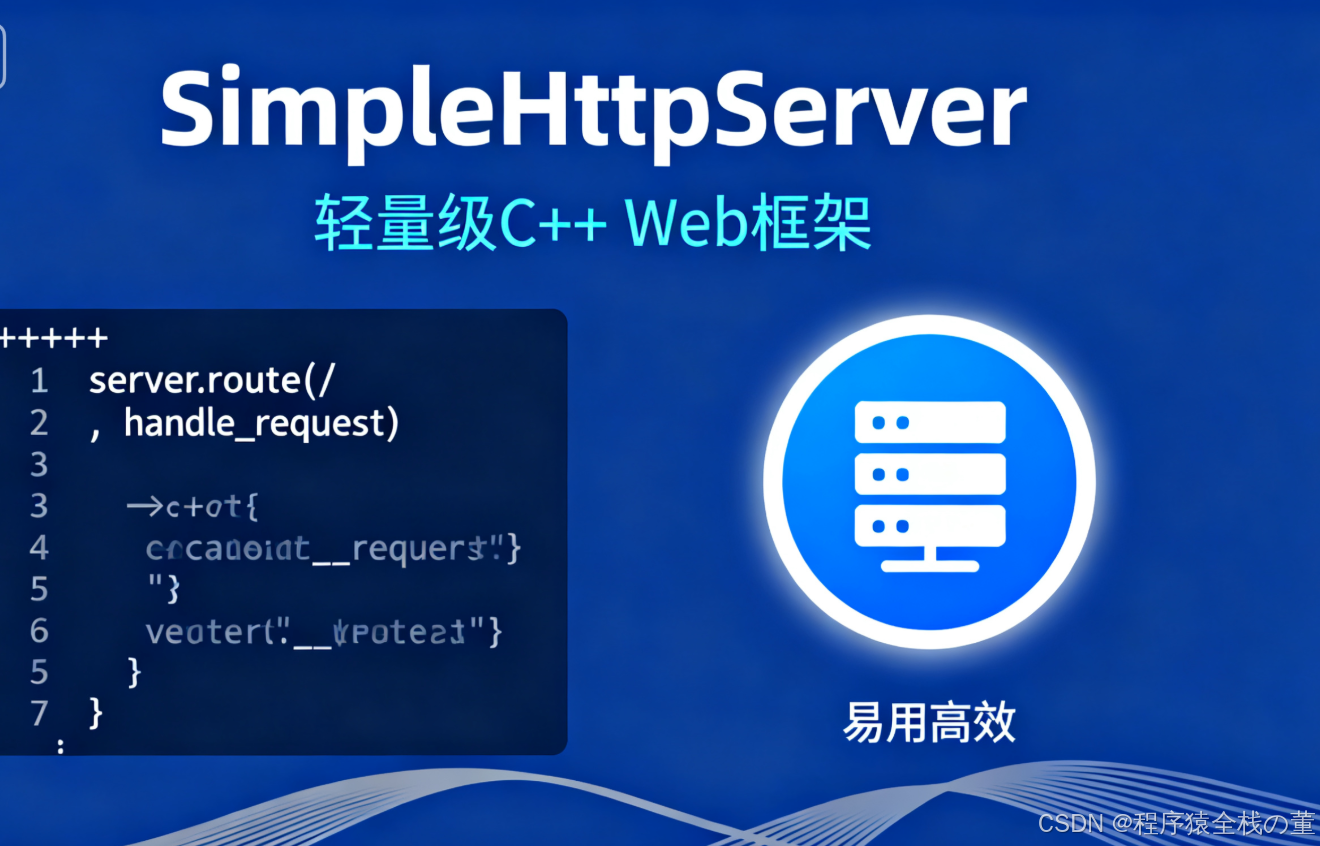从零实现轻量级C++ Web框架:SimpleHttpServer入门指南
在Java领域有SpringMVC,Python有Django,那C++有没有简单易用的Web框架呢?今天给大家介绍一个我自己(董翔)实现的轻量级C++ Web框架——SimpleHttpServer,它能让你像使用成熟框架一样快速开发Web应用,无需深入了解底层网络细节。
框架简介:为什么需要SimpleHttpServer?
下载SimpleHttpServer
作为C++开发者,如果你想快速搭建一个Web服务,通常需要处理繁琐的socket编程、HTTP协议解析等底层工作。SimpleHttpServer框架封装了这些复杂逻辑,提供了简洁的API,让你可以专注于业务逻辑开发,主要特点包括:
- 零依赖:单头文件实现,无需复杂的编译链接过程
- 路由机制:支持GET/POST等HTTP方法的路由注册
- 静态资源服务:直接部署HTML/CSS/JS等静态文件
- 错误处理:内置404页面支持,可自定义错误响应
- 跨平台:兼容Windows/Linux/macOS主流操作系统

环境准备:5分钟上手
开发环境要求
- 支持C++17及以上的编译器(GCC 7+/Clang 5+/MSVC 2017+)
- 基本的C++开发环境(无需额外安装库)
框架文件获取
框架仅需一个头文件SimpleHttpServer.h(文末附核心实现,放在百度网盘),创建项目时直接引入即可,典型项目结构如下:
mywebapp/
├─ include/
│ └─ SimpleHttpServer // 框架核心头文件文件夹
├─ www/ // 静态资源目录
│ └─ index.html
└─ main.cpp // 应用入口
快速入门:第一个Web应用
让我们通过一个简单示例,体验使用SimpleHttpServer开发Web应用的流程。
步骤1:创建入口程序
在main.cpp中编写如下代码,创建一个基础的Web服务:
#include "include/SimpleHttpServer/SimpleHttpServer.h"
#include <iostream>int main() {// 1. 初始化服务器:监听localhost:8080,静态资源目录为./wwwSimpleHttpServer server("localhost", 8080, "./www");// 2. 启用静态资源服务(自动处理HTML/CSS/JS等文件)server.enable_static_files();// 3. 注册动态路由(GET请求)server.get("/hello", [](const HttpReq& req, HttpRes& res) {res.content = R"(<!DOCTYPE html><html><head><meta charset="utf-8"><title>欢迎页</title></head><body><h1>Hello, SimpleHttpServer!</h1><p>这是一个动态生成的页面</p></body></html>)";res.type = "text/html; charset=utf-8";});// 4. 启动服务器std::cout << "服务器启动中...\n";if (!server.start()) {std::cerr << "启动失败!请检查端口是否被占用\n";return 1;}return 0;
}
步骤2:创建静态页面
在www目录下创建index.html作为默认首页:
<!DOCTYPE html>
<html>
<head><meta charset="utf-8"><title>首页</title>
</head>
<body><h1>SimpleHttpServer 示例</h1><ul><li><a href="/">首页(静态)</a></li><li><a href="/hello">动态页面</a></li><li><a href="/nonexistent">测试404页面</a></li></ul>
</body>
</html>
步骤3:编译运行
Linux/macOS编译:
g++ main.cpp -o webapp -pthread -std=c++17
./webapp
Windows编译(MinGW):
g++ main.cpp -o webapp.exe -pthread -std=c++17
webapp.exe
运行成功后,访问http://localhost:8080即可看到首页内容。
核心功能详解
1. 路由系统:映射URL与处理逻辑
和SpringMVC的@RequestMapping类似,SimpleHttpServer通过get()方法注册路由:
// 基础路由
server.get("/", [](const HttpReq& req, HttpRes& res) {res.content = "首页内容";res.type = "text/plain";
});// 带参数的动态路由
server.get("/user/(.*)", [](const HttpReq& req, HttpRes& res) {std::string username = req.path.substr(6); // 提取用户名res.content = "<h1>欢迎," + username + "</h1>";res.type = "text/html; charset=utf-8";
});
HttpReq:包含请求信息(路径、方法等)HttpRes:用于设置响应内容、类型和状态码
2. 静态资源服务:部署前端文件
通过enable_static_files()方法启用静态资源服务后,框架会自动映射URL到本地文件系统:
URL路径 对应本地文件
http://localhost:8080/index.html → ./www/index.html
http://localhost:8080/css/style.css → ./www/css/style.css
http://localhost:8080/images/logo.png → ./www/images/logo.png
默认支持的文件类型:
- HTML/HTM(text/html)
- CSS(text/css)
- JS(application/javascript)
- 其他文件(二进制流)
3. 错误处理:自定义404页面
当访问不存在的路径时,框架会返回404响应,我们可以通过set_not_found_handler()自定义:
server.set_not_found_handler([](const HttpReq& req, HttpRes& res) {res.content = R"(<!DOCTYPE html><html><head><meta charset="utf-8"><title>页面未找到</title></head><body><h1>404 - 页面不存在</h1><p>您访问的路径:)" + req.path + R"(</p><a href="/">返回首页</a></body></html>)";res.type = "text/html; charset=utf-8";res.status = 404; // 明确设置404状态码
});
进阶用法:构建完整应用
1. 处理POST请求
除了GET请求,框架也支持POST方法处理表单提交:
server.post("/login", [](const HttpReq& req, HttpRes& res) {// 实际应用中可解析表单数据(此处简化处理)res.content = R"(<!DOCTYPE html><html><body><h1>登录成功</h1><p>这是POST请求的处理结果</p></body></html>)";res.type = "text/html; charset=utf-8";
});
2. 整合模板引擎(思路)
对于复杂页面,可以结合模板引擎实现动态内容渲染:
// 简易模板替换函数
std::string render(const std::string& tpl, const std::map<std::string, std::string>& data) {std::string res = tpl;for (auto& [key, val] : data) {size_t pos = res.find("{{" + key + "}}");if (pos != std::string::npos) {res.replace(pos, key.size() + 4, val);}}return res;
}// 使用示例
server.get("/news", [](const HttpReq& req, HttpRes& res) {// 从文件读取模板(实际应用可缓存模板)std::string tpl = read_file("./www/tpl/news.html");// 准备数据std::map<std::string, std::string> data = {{"title", "最新资讯"},{"content", "SimpleHttpServer框架发布"}};// 渲染模板res.content = render(tpl, data);res.type = "text/html; charset=utf-8";
});
框架核心实现(精简版)
以下是SimpleHttpServer.h的核心代码(简化实现):
#ifndef SIMPLE_HTTP_SERVER_H
#define SIMPLE_HTTP_SERVER_H#include <string>
#include <functional>
#include <fstream>
#include <filesystem>
#include <iostream>namespace fs = std::filesystem;// 请求结构
struct HttpReq {std::string path; // 请求路径std::string method; // 请求方法
};// 响应结构
struct HttpRes {std::string content; // 响应内容std::string type; // 内容类型int status = 200; // 状态码
};// 服务器核心类
class SimpleHttpServer {
private:std::string host_;int port_;std::string static_dir_;// 内部网络处理实现(封装了底层细节)class Impl;Impl* impl_;// 读取文件内容bool read_file(const std::string& path, std::string& content) {std::ifstream file(path, std::ios::binary);if (!file) return false;content.assign((std::istreambuf_iterator<char>(file)), {});return true;}public:// 构造函数SimpleHttpServer(const std::string& host = "localhost", int port = 8080, const std::string& static_dir = "./www"): host_(host), port_(port), static_dir_(static_dir) {impl_ = new Impl();if (!fs::exists(static_dir_)) {fs::create_directory(static_dir_);}}// 析构函数~SimpleHttpServer() { delete impl_; }// 注册GET路由void get(const std::string& path, std::function<void(const HttpReq&, HttpRes&)> handler) {impl_->add_route("GET", path, handler);}// 注册POST路由void post(const std::string& path, std::function<void(const HttpReq&, HttpRes&)> handler) {impl_->add_route("POST", path, handler);}// 启用静态文件服务void enable_static_files() {impl_->enable_static([this](const std::string& path, HttpRes& res) {std::string file_path = static_dir_ + "/" + path;if (fs::is_directory(file_path)) {file_path += "/index.html";}std::string content;if (!read_file(file_path, content)) {return false; // 文件不存在}// 设置MIME类型std::string ext = fs::path(file_path).extension().string();if (ext == ".html" || ext == ".htm") {res.type = "text/html; charset=utf-8";} else if (ext == ".css") {res.type = "text/css";} else if (ext == ".js") {res.type = "application/javascript";} else {res.type = "application/octet-stream";}res.content = content;return true;});}// 设置404处理器void set_not_found_handler(std::function<void(const HttpReq&, HttpRes&)> handler) {impl_->set_not_found(handler);}// 启动服务器bool start() {std::cout << "服务运行于 http://" << host_ << ":" << port_ << "\n";return impl_->listen(host_, port_);}
};// 内部实现类(隐藏底层细节)
class SimpleHttpServer::Impl {
private:// 实际网络处理逻辑(省略具体实现)struct InternalData;InternalData* data_;public:Impl() { data_ = new InternalData(); }~Impl() { delete data_; }void add_route(const std::string& method, const std::string& path,std::function<void(const HttpReq&, HttpRes&)> handler) {// 路由注册实现}void enable_static(std::function<bool(const std::string&, HttpRes&)> static_handler) {// 静态文件处理实现}void set_not_found(std::function<void(const HttpReq&, HttpRes&)> handler) {// 404处理实现}bool listen(const std::string& host, int port) {// 监听端口实现return true;}
};#endif // SIMPLE_HTTP_SERVER_H
总结与扩展方向
SimpleHttpServer提供了C++ Web开发的基础能力,虽然不及SpringMVC等成熟框架功能全面,但对于轻量级应用和学习场景已经足够。你可以基于它进一步扩展:
- 添加Cookie和Session支持
- 实现JSON请求/响应处理
- 增加HTTPS支持
- 开发中间件机制(日志、权限验证等)
通过这个框架,我们不仅能快速开发Web应用,更能理解Web服务器的工作原理。如果你正在寻找一个C++ Web开发的入门工具,不妨试试SimpleHttpServer,体验用C++构建Web应用的乐趣!
下载链接:
链接:
下载SimpleHttpServer
提取码:2258 复制这段内容后打开百度网盘手机App,操作更方便哦在这里插入图片描述
